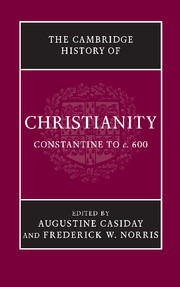Book contents
- Frontmatter
- Introduction
- Part I Christianity: Regional Developments
- Part II Christianity Contested
- Part III Christian Culture and Society
- Part IV Christian Beliefs and Practices
- 18 Discourse on the Trinity
- 19 History of Christology to the seventh century
- 20 Sin and salvation: Experiences and reflections
- 21 From Antioch to Arles: Lay devotion in context
- 22 Saints and holy men
- 23 Pastoral care and discipline
- 24 Sexuality, marriage and the family
- 25 The growth of liturgy and the church year
- 26 Interpreting scripture
- 27 Asceticism and monasticism, I: Eastern
- 28 Asceticism and monasticism, II: Western
- 29 Art and Propaganda fide: Christian art and architecture, 300–600
- Index
- Map 1 The Roman empire, c. 400">
- References
21 - From Antioch to Arles: Lay devotion in context
from Part IV - Christian Beliefs and Practices
Published online by Cambridge University Press: 28 March 2008
- Frontmatter
- Introduction
- Part I Christianity: Regional Developments
- Part II Christianity Contested
- Part III Christian Culture and Society
- Part IV Christian Beliefs and Practices
- 18 Discourse on the Trinity
- 19 History of Christology to the seventh century
- 20 Sin and salvation: Experiences and reflections
- 21 From Antioch to Arles: Lay devotion in context
- 22 Saints and holy men
- 23 Pastoral care and discipline
- 24 Sexuality, marriage and the family
- 25 The growth of liturgy and the church year
- 26 Interpreting scripture
- 27 Asceticism and monasticism, I: Eastern
- 28 Asceticism and monasticism, II: Western
- 29 Art and Propaganda fide: Christian art and architecture, 300–600
- Index
- Map 1 The Roman empire, c. 400">
- References
Summary
The legalisation of Christianity by the emperor Constantine launched a new era for Christian devotion, as urban processions, sumptuous churches and monastic settlements lent greater visibility to this religious minority. In the aftermath of imperial toleration, theologians reflected ever more profoundly on the incarnation, the belief that God sanctified the human body in the person of Christ. The proliferation of pilgrimage centres, relics, and eventually sacred images lent even richer expression to the notion that God entered matter – not just one body, but several, not just one place, but the created world and all it contained. In this revelatory drama, Christians explored how the body might know God through each of its physical senses and its movements in space. The ascetic movement, in its intense scrutiny and discipline of the body, reflects this incarnational impulse. Yet, so too can the lives of ordinary Christians, who never imagined for themselves any withdrawal or flight from the thick web of this world.
Despite the religion’s greater visibility in that day, the ‘voices’ of ordinary Christians remain difficult to recover. Prominent bishops and church leaders wrote extensively to lay Christian elites. With rare exception, however, letters by lay Christians to these leaders have not survived. Details about daily life and devotions of ordinary Christians emerge on the margins of sacred biography. Sermons preached to lay Christian audiences may also yield insight into urban realities, but inevitably through the homilist’s eyes. Despite such biases, sermons are one of the few Christian genres delivered in settings where laypersons gathered in significant numbers. Recent research on such homilies has revealed valuable information on the diversity of the audience and its interactions with the preacher.
Keywords
- Type
- Chapter
- Information
- The Cambridge History of Christianity , pp. 531 - 547Publisher: Cambridge University PressPrint publication year: 2007
References
- 1
- Cited by

